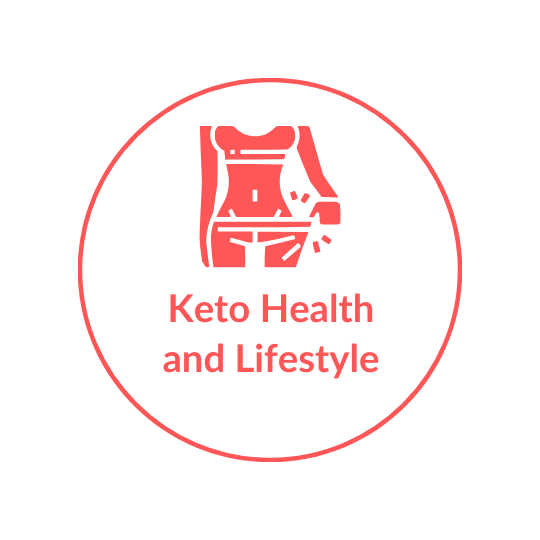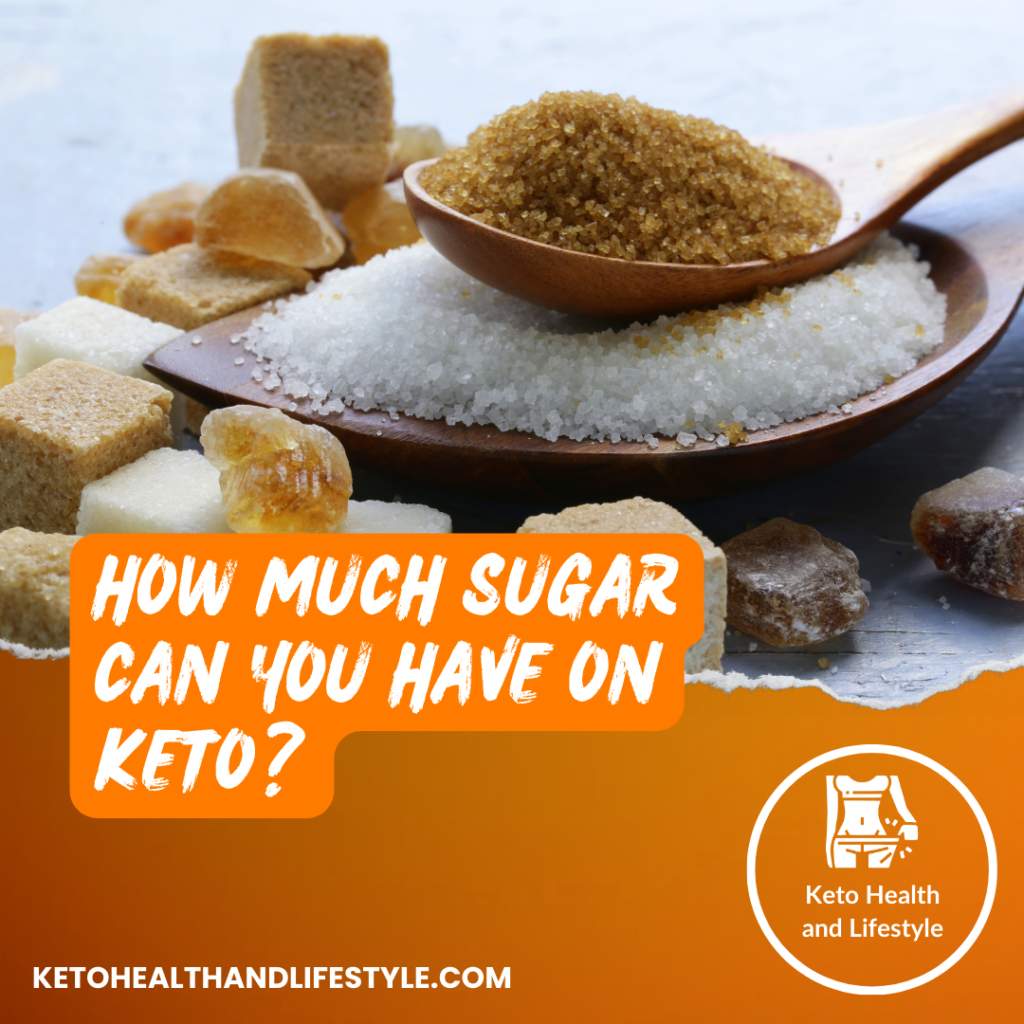This post may contain affiliate links which means I may receive a commission for purchases made through links. Learn more about policies on my about page.
TL;DR for busy readers
How much sugar can you have on a keto diet?
- Your sugar intake should be limited to 20-50 grams per day, including all carbohydrates. This means drastically reducing added sugars and being mindful of hidden sugars in common foods.
- While natural sugars from low-carb vegetables and some dairy are generally acceptable in moderation, it’s crucial to read nutrition labels and choose keto-friendly sweeteners wisely.
Table of Contents
Introduction
The ketogenic diet, commonly known as the keto diet, is a low-carb, high-fat dietary regimen designed to shift the body’s metabolism from burning carbohydrates to burning fat. While adhering to this lifestyle, understanding how much sugar can you have on keto is crucial. Here we explore how much sugar one can include in a keto diet, examining both natural and processed sugars, hidden sugars, and suitable sweeteners for maintaining ketosis.
The Role of Sugar as a Carbohydrate
Sugar, primarily composed of glucose and fructose, is a carbohydrate that provides energy to the body. However, during ketosis, the body’s primary energy source shifts from carbohydrates to fats, making sugar consumption a critical factor to monitor. Even minor amounts of sugar can disrupt this metabolic state, leading to an increase in insulin levels and a potential return to glucose burning.
Understanding the carbohydrate limit is essential for keto dieters. The general guideline is to restrict total carbohydrate intake to around 20-50 grams per day. This includes all carbohydrates, from sugars to fibers, and must be carefully calculated to ensure continued ketosis.
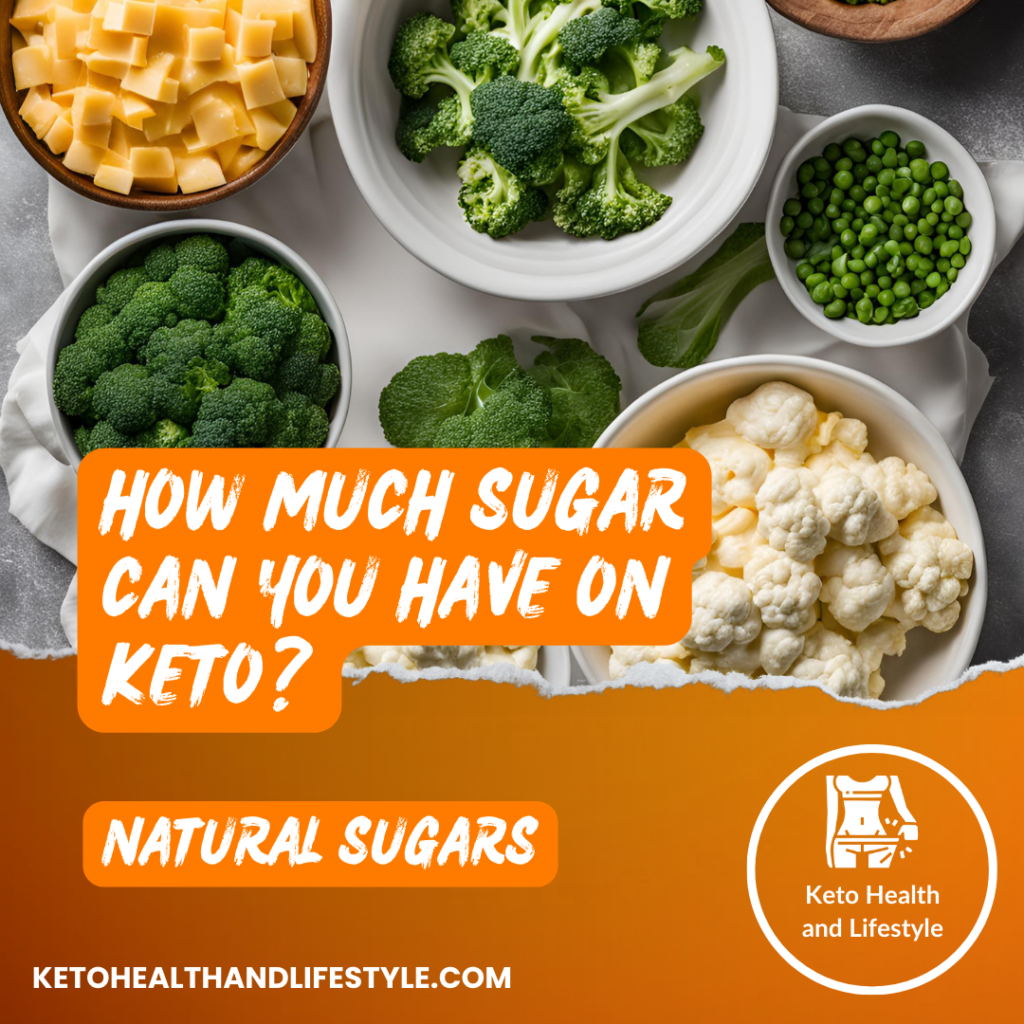
Natural Sugars in Low-Carb Vegetables and Dairy Products
Understanding Natural Sugars
Natural sugars, such as those found in fruits, vegetables, and dairy, are often considered healthier than added sugars. They come packed with essential nutrients, fibers, and vitamins. However, even natural sugars can contribute to overall carbohydrate intake, so it’s crucial for keto followers to be mindful of their consumption.
For instance, vegetables like spinach, kale, and broccoli contain small amounts of natural sugars but are low in carbohydrates overall, making them suitable for a keto diet. Dairy products also contain lactose, a natural sugar, which must be accounted for when planning meals.
Examples of Low-Carb Vegetables and Dairy
- Spinach: Approximately 1 gram of net carbs per cup.
- Broccoli: Around 4 grams of net carbs per cup.
- Cauliflower: About 2 grams of net carbs per cup.
- Cheddar Cheese: Contains less than 1 gram of net carbs per ounce.
- Heavy Cream: Approximately 0.5 grams of net carbs per tablespoon.
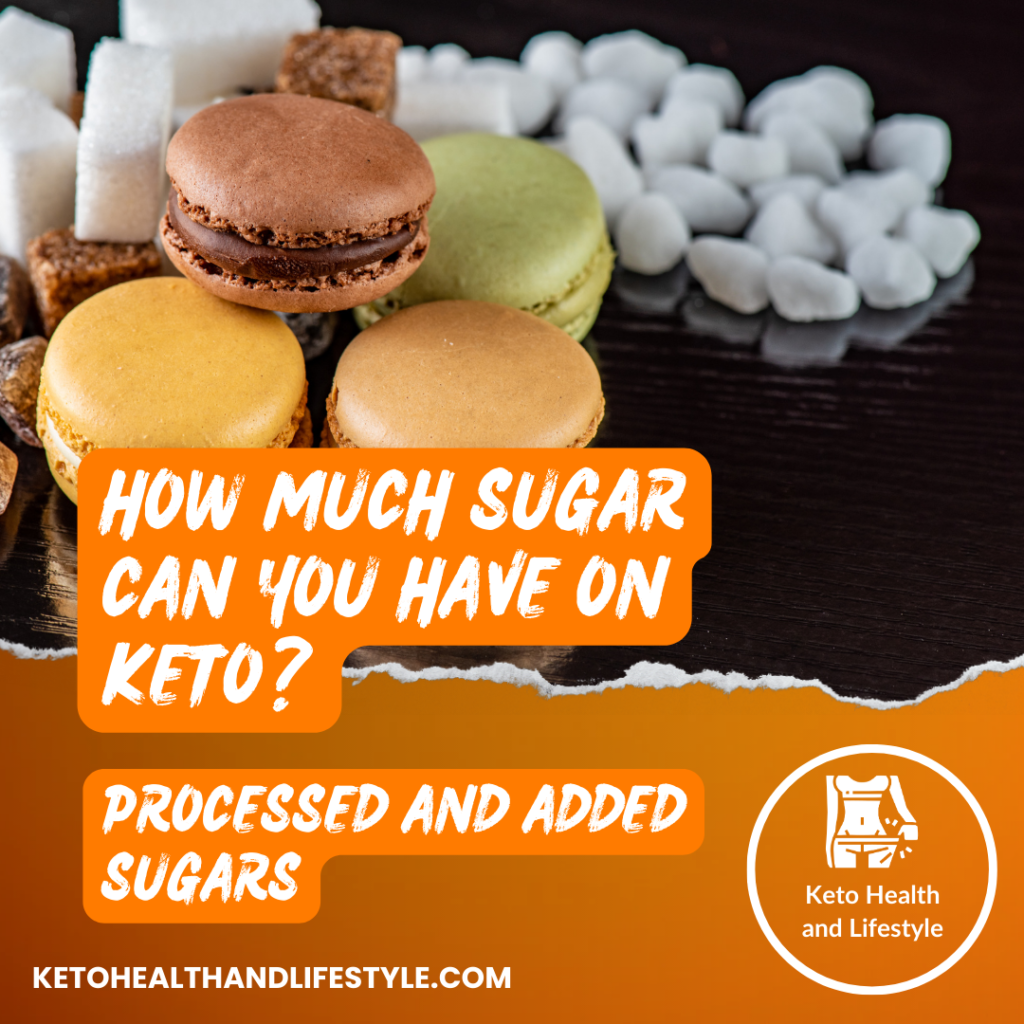
Processed and Added Sugars
Defining Processed Sugars
Processed sugars are derived from refining processes and include white sugar, brown sugar, and high-fructose corn syrup. These sugars offer empty calories with no nutritional benefits and can significantly impact blood sugar levels. For those on a keto diet, these processed sugars are often the most significant threat to maintaining a state of ketosis.
Once consumed, processed sugars quickly convert to glucose in the bloodstream, prompting an insulin response that can hinder fat burning. It is imperative for keto followers to eliminate these sugars from their diets entirely to promote a healthy metabolic state.

Recommended Reading: Discover keto-friendly foods and what to avoid
Impact on Ketosis
The introduction of processed sugars can lead to a swift exit from ketosis. The body will prioritise burning glucose over fat if sugar intake is too high, making it essential to avoid all forms of added sugars. This rule extends not only to sweets and desserts but also to many packaged foods that may contain hidden sugars.
By being vigilant and avoiding processed sugars, individuals can better ensure that they remain in ketosis, allowing their bodies to efficiently burn fat for fuel.
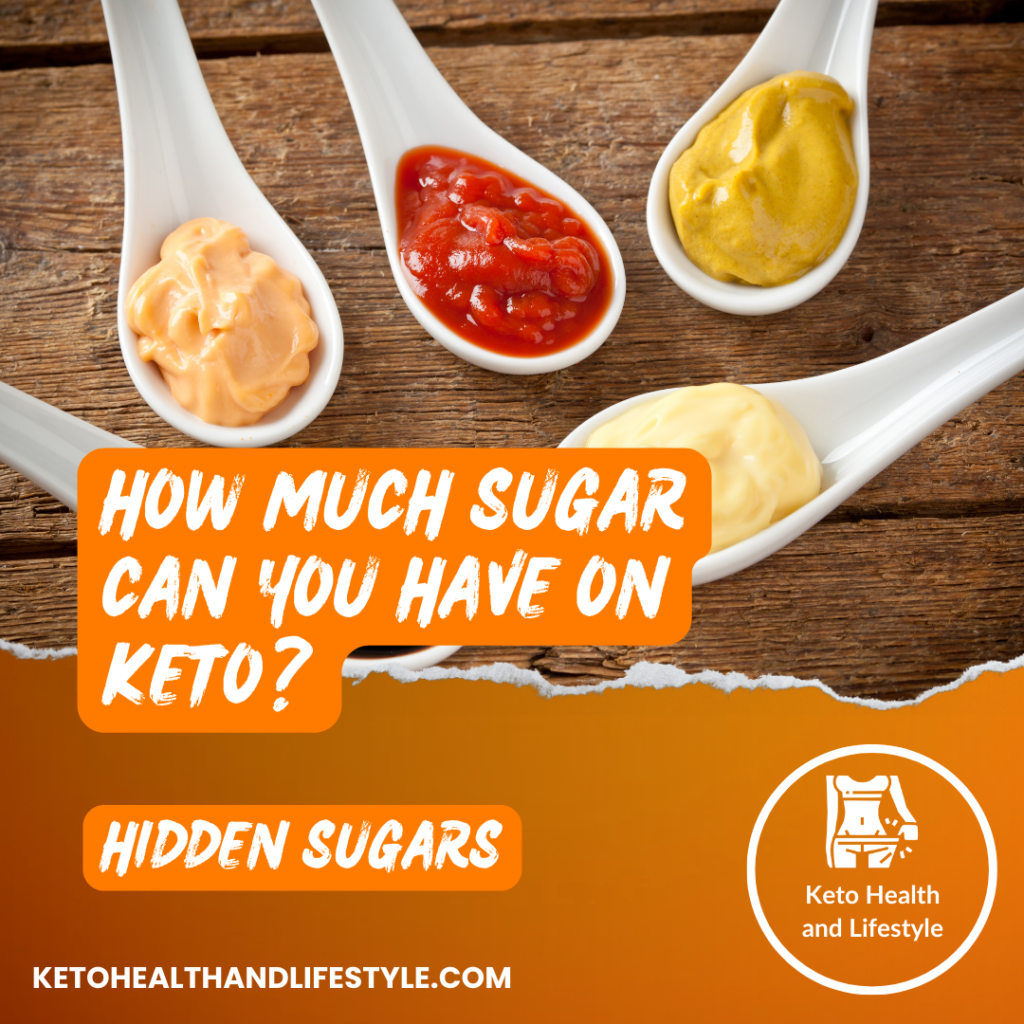
Hidden Sugars in Condiments, Sauces, and Dressings
Common Sources of Hidden Sugars
Many individuals overlook the presence of hidden sugars in everyday condiments, sauces, and dressings. Items such as ketchup, barbecue sauce, and salad dressings may contain added sugars that can quickly add up and disrupt ketosis. It is essential to be aware of these hidden sources to maintain a low carb intake.
For example, a tablespoon of ketchup can contain about 4 grams of sugar, while certain salad dressings may have up to 3 grams per serving. Understanding these figures helps keto dieters make informed decisions about what to include in their meals.
Identifying Hidden Sugars
Identifying hidden sugars involves scrutinising ingredient lists and nutritional labels. Terms such as sucrose, glucose, fructose, syrup, and any ingredient ending in -ose usually indicates added sugar. Being educated about these terms allows for better dietary choices and helps maintain a low carb consumption level.
Taking the time to read labels can prevent accidental sugar intake and keep your carbohydrate count within the desired range.
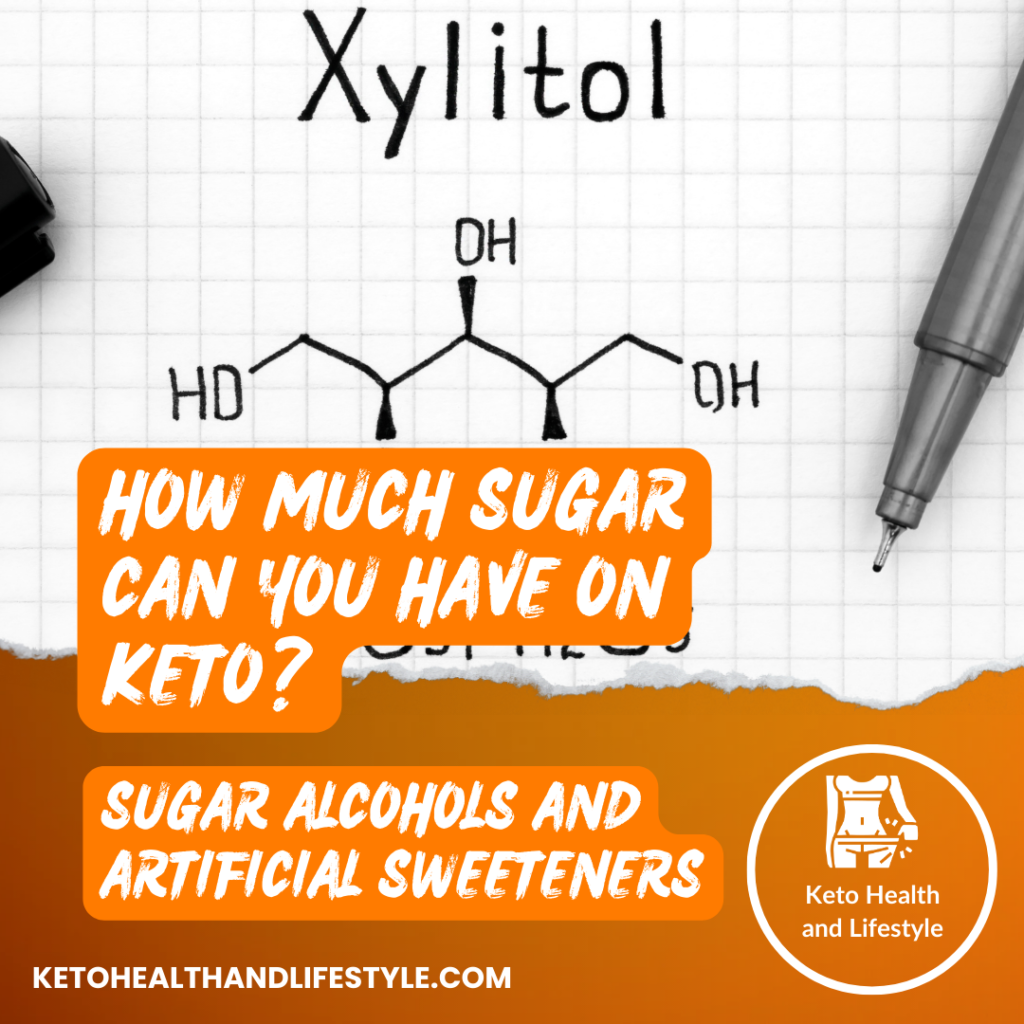
Sugar Alcohols and Artificial Sweeteners
Types of Sugar Alcohols
Sugar alcohols, such as erythritol, xylitol, and maltitol, are frequently used as sugar substitutes in keto-friendly products. They are lower in calories than sugar and have a minor impact on blood sugar levels, making them a popular choice for those looking to satisfy their sweet tooth without the guilt.
Among these, erythritol is the most keto-friendly option, containing only 0.24 calories per gram and having little to no effect on blood glucose levels. Other sugar alcohols, while lower in calories, can cause digestive distress in some individuals when consumed in excess.
Benefits and Drawbacks
While sugar alcohols can provide a sweet flavor without significant carbs, it is crucial to moderate their consumption to avoid gastrointestinal issues. Additionally, some sugar alcohols can still impact insulin levels and should be used judiciously. For instance, maltitol can raise blood sugar significantly, making it less ideal for a strict keto diet.
Ultimately, understanding the benefits and limitations of sugar alcohols allows keto followers to make informed choices about incorporating these sweeteners into their meal plans.

Nutrition Labels for Identifying Hidden Sugars
Reading Nutrition Labels Effectively
Nutrition labels can be instrumental in identifying both visible and hidden sugars. Reading these labels helps consumers understand the total carbohydrate content and the types of sugars included, allowing for better dietary planning. Look for the Total Carbohydrates section, which gives the complete carb count, including sugars and fibers.
It is also essential to pay attention to the serving size, as many packaged foods can contain multiple servings per container, which can easily lead to exceeding daily carbohydrate limits.
Key Terms to Look For
Some key terms to look for on nutrition labels include ‘added sugars,’ ‘sugar alcohols,’ and various sugar names like ‘cane sugar,’ ‘corn syrup,’ and ‘fruit juice concentrate.’ By familiarising oneself with these terms, consumers can more effectively navigate food selections and minimise their sugar intake.
Being proactive in reading labels ensures that individuals on a keto diet can maintain their carbohydrate goals while still enjoying a variety of foods.
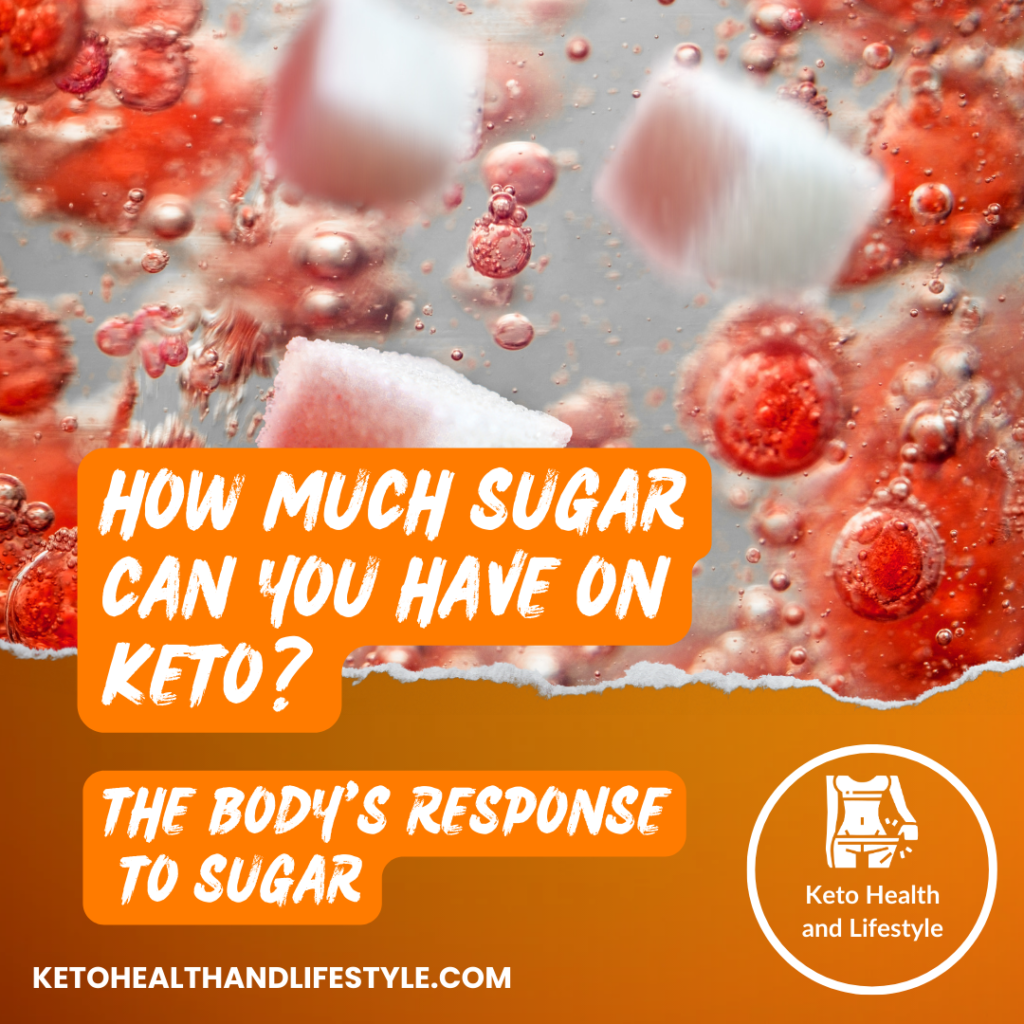
The Body’s Response to Sugar
Impact on Insulin and Blood Sugar Levels
When sugars are consumed, they trigger an insulin response, aimed at regulating blood sugar levels. For those on a keto diet, high sugar intake can lead to insulin spikes, which not only jeopardise ketosis but also contribute to energy crashes and increased hunger. A stable blood sugar level is essential for maintaining energy and controlling cravings.
Understanding how the body metabolises sugar helps individuals make informed dietary choices that favor a steady energy supply, crucial for sustaining the keto lifestyle.

Recommended Reading: Dive deep into the science of ketosis
Effects on Ketosis
The presence of sugar can directly affect ketone production, the byproduct of fat burning that fuels the body during ketosis. When insulin levels rise due to sugar intake, ketone production diminishes, leading to a potential halt in fat burning. This cycle emphasises the importance of monitoring sugar consumption to maintain ketosis.
In essence, keeping sugar levels low safeguards against disruptions to the body’s ability to utilise fat for energy, allowing keto followers to remain in a fat-burning state.
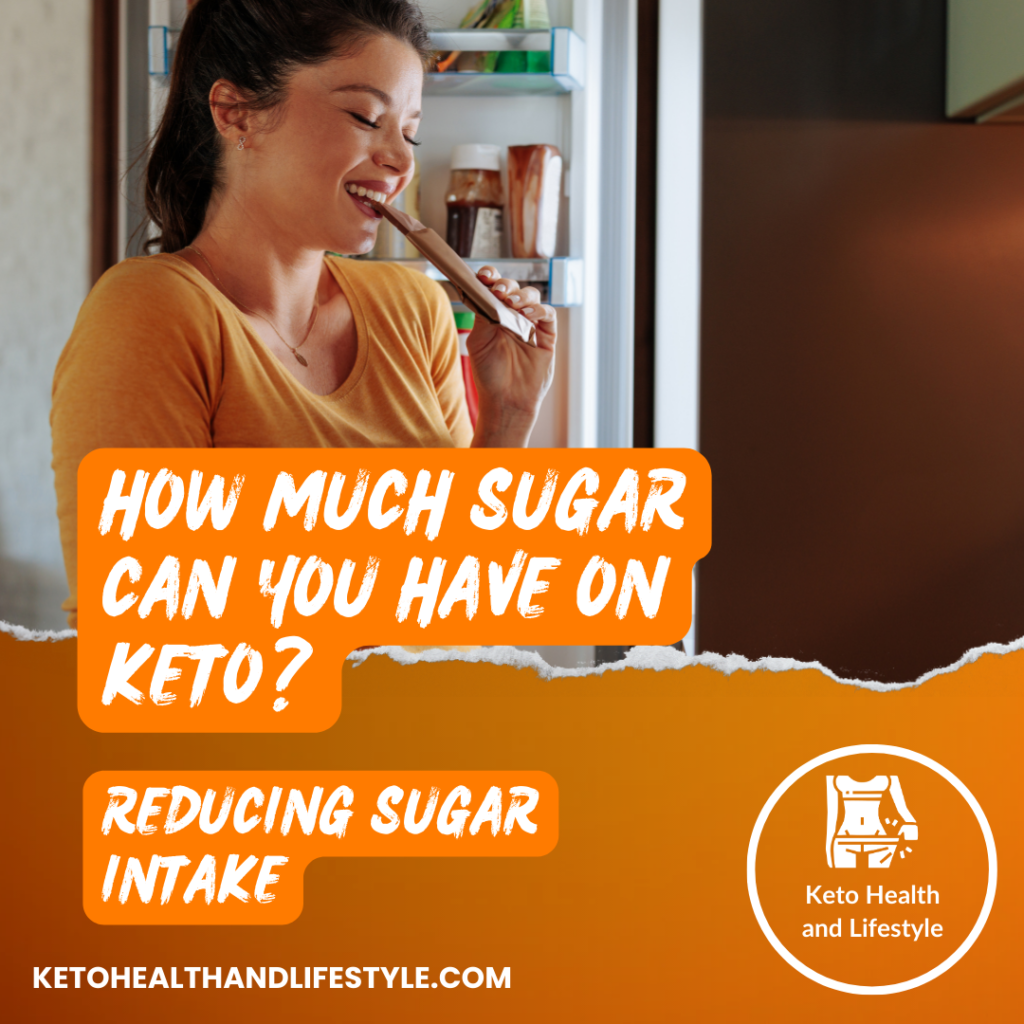
Managing Sugar Cravings on Keto
Techniques for Reducing Sugar Intake
Managing sugar cravings while on a keto diet often requires strategic planning and mindfulness. One effective technique is to incorporate more healthy fats into meals, which can help increase satiety and reduce the desire for sugary foods. For instance, adding avocado, nuts, and seeds can provide essential nutrients and keep hunger at bay.
Another approach is to gradually reduce sugar intake instead of eliminating it all at once. This method allows the taste buds to adjust over time, making it easier to forgo sweet flavors without feeling deprived.
Making the Transition to Keto Easier
Transitioning to a keto lifestyle can be challenging, especially regarding sugar cravings. To ease this transition, consider incorporating keto-friendly sweeteners in moderation. These can provide the necessary sweetness without the impact on blood sugar and can help make the shift less daunting.
Additionally, staying hydrated and engaging in regular physical activity can promote better mood and energy levels, minimising the urge for sugary snacks.
Easy-to-Follow Tips for Reducing Sugar Intake:
- Read nutrition labels carefully to identify hidden sugars in packaged foods.
- Replace sugary drinks with water, unsweetened tea, or coffee.
- Choose whole foods over processed options to avoid added sugars.
- Gradually reduce sugar in your diet to help manage cravings.
- Use keto-friendly sweeteners like erythritol or stevia in moderation.
- Incorporate low-carb vegetables to satisfy sweet cravings naturally.
- Be mindful of condiments and sauces, which often contain hidden sugars.
- Prepare meals at home to have better control over sugar content.
- Opt for full-fat dairy products, which typically contain less sugar than low-fat versions.
- Stay hydrated, as thirst can sometimes be mistaken for sugar cravings.
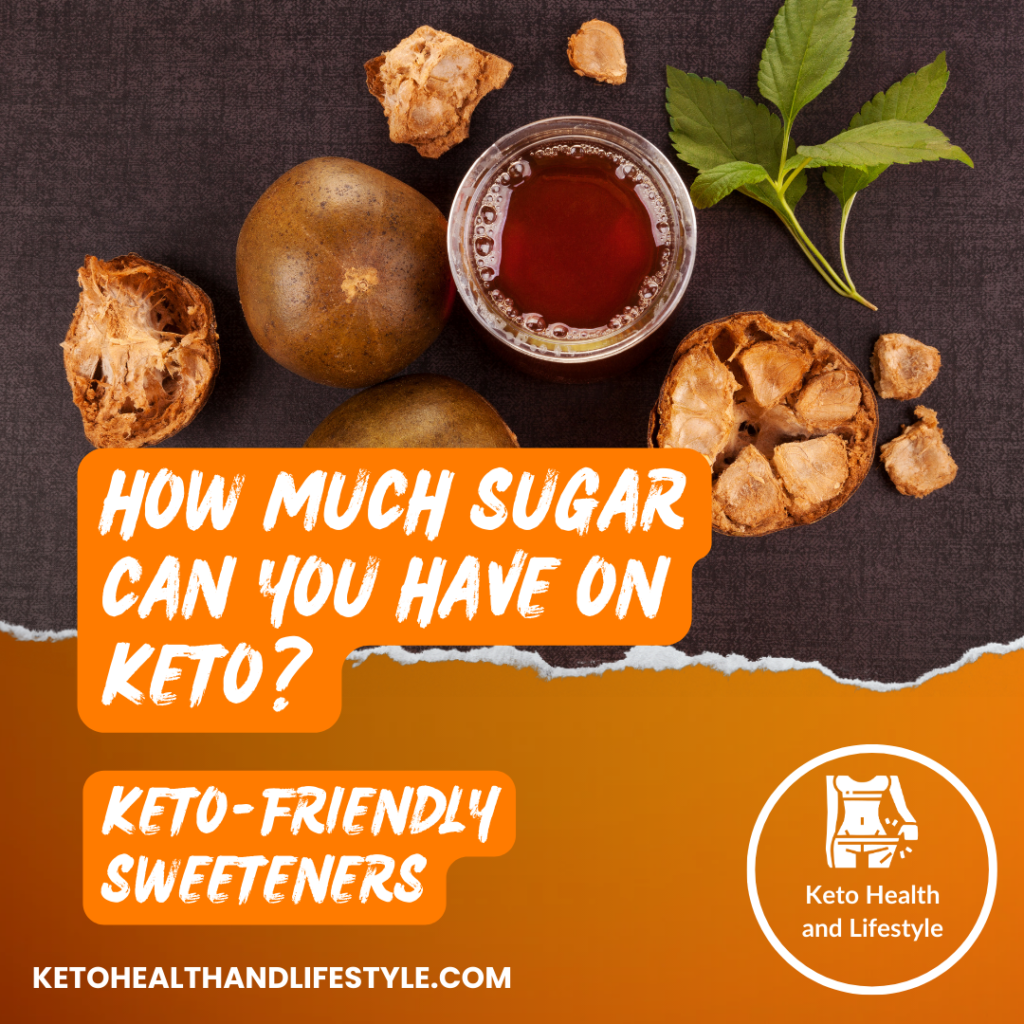
Some Keto-Friendly Sweeteners
Keto-Friendly Sugar Alternatives
There are several popular keto-friendly sweeteners available that allow individuals to satisfy their sweet cravings while adhering to low-carb guidelines. Erythritol, stevia, and monk fruit are among the most favored options. These sweeteners offer a sugar-like taste with minimal to zero calories and carbohydrates.
Each of these sweeteners has its unique properties; for example, stevia is derived from the leaves of the Stevia plant and offers a sweetness level that is much greater than sugar, allowing for smaller quantities to achieve the desired sweetness. Learn about low-carb recipe alternatives.
| Sweetener | Impact on Ketosis | Calories per Serving (tsp) | Net Carbs (g) |
| Erythritol | 0 calories, low carb, won’t spike blood sugar | 0 | 0 |
| Stevia | 0 calories, can vary in carbs, may affect some people | 0 | 1 |
| Monk Fruit | Contains natural sugars but low carb, often safe | 0 | 2 |
| Aspartame | Contains calories, may affect ketosis for some | 4 | 1 |
| Xylitol | Moderate carbs, may affect ketosis | 9 | 4 |
| Honey | High in sugar and carbs, generally not keto-friendly | 21 | 17 |
Using Sweeteners in Cooking and Baking
When using keto-friendly sweeteners in cooking and baking, it is essential to understand their conversion ratios compared to sugar, as they are often sweeter than traditional sugar. Recipes may need adjustments to achieve the right flavor balance. Additionally, some sweeteners may react differently when heated, so it’s vital to choose suitable options for specific cooking methods.
By experimenting with these sweeteners, individuals can create a variety of delicious and satisfying dishes that align with their keto lifestyle.
Conclusion
Summary of Sugar Intake on Keto
In summary, maintaining a low sugar intake is pivotal for those on a ketogenic diet. Understanding the types of sugars, being cautious about hidden sugars, and selecting the right sweeteners can significantly influence one’s success in achieving and maintaining ketosis.
By prioritising natural low-carb foods, minimising processed sugars, and employing sugar substitutes wisely, individuals can enjoy a diverse diet while adhering to their ketogenic goals.
Final Thoughts on Maintaining a Keto Lifestyle
Ultimately, the journey to a successful keto lifestyle involves education, mindfulness, and strategic planning. By being aware of sugar intake and its impact on the body, keto enthusiasts can enjoy a fulfilling and healthy diet without sacrificing flavor or enjoyment.
FAQs
1. Can I have any sugar on a keto diet?
While small amounts of natural sugars from low-carb vegetables and dairy can be acceptable, it’s best to avoid processed sugars completely to maintain ketosis.
2. What are the best sweeteners to use on keto?
Popular keto sweeteners include erythritol, stevia, and monk fruit, as they provide sweetness with minimal impact on blood sugar.
3. How do I identify hidden sugars in products?
Reading labels carefully for terms like sucrose, high-fructose corn syrup, and any ingredient that ends in -ose can help identify hidden sugars.
4. Is it okay to use sugar alcohols on keto?
Sugar alcohols like erythritol can be used in moderation, but it’s essential to be cautious as some may affect insulin response.
5. How can I reduce cravings for sugar on a keto diet?
Incorporating healthy fats, staying hydrated, and gradually reducing sugar intake can help manage cravings effectively.
- Keto Wine: Best Zero Carb Wines 2025 Guide for Low-Carb Living
- Keto Crunch Cereal: Is Catalina Crunch Keto Friendly? Nutrition Facts & Review 2025
- Is Dragon Fruit Keto Friendly? Carbs & Keto Guide for 2025 Fitness and Diet Success
- Is Jicama Keto Friendly? Nutrition Facts, Health Benefits & Easy Recipes for Keto 2025
- Is SkinnyPop Popcorn Keto Friendly? Honest Carb Guide & Nutrition 2025
- Keto Diet Kitchen Essentials: 7 Helpful Things I Can’t Live Without!
